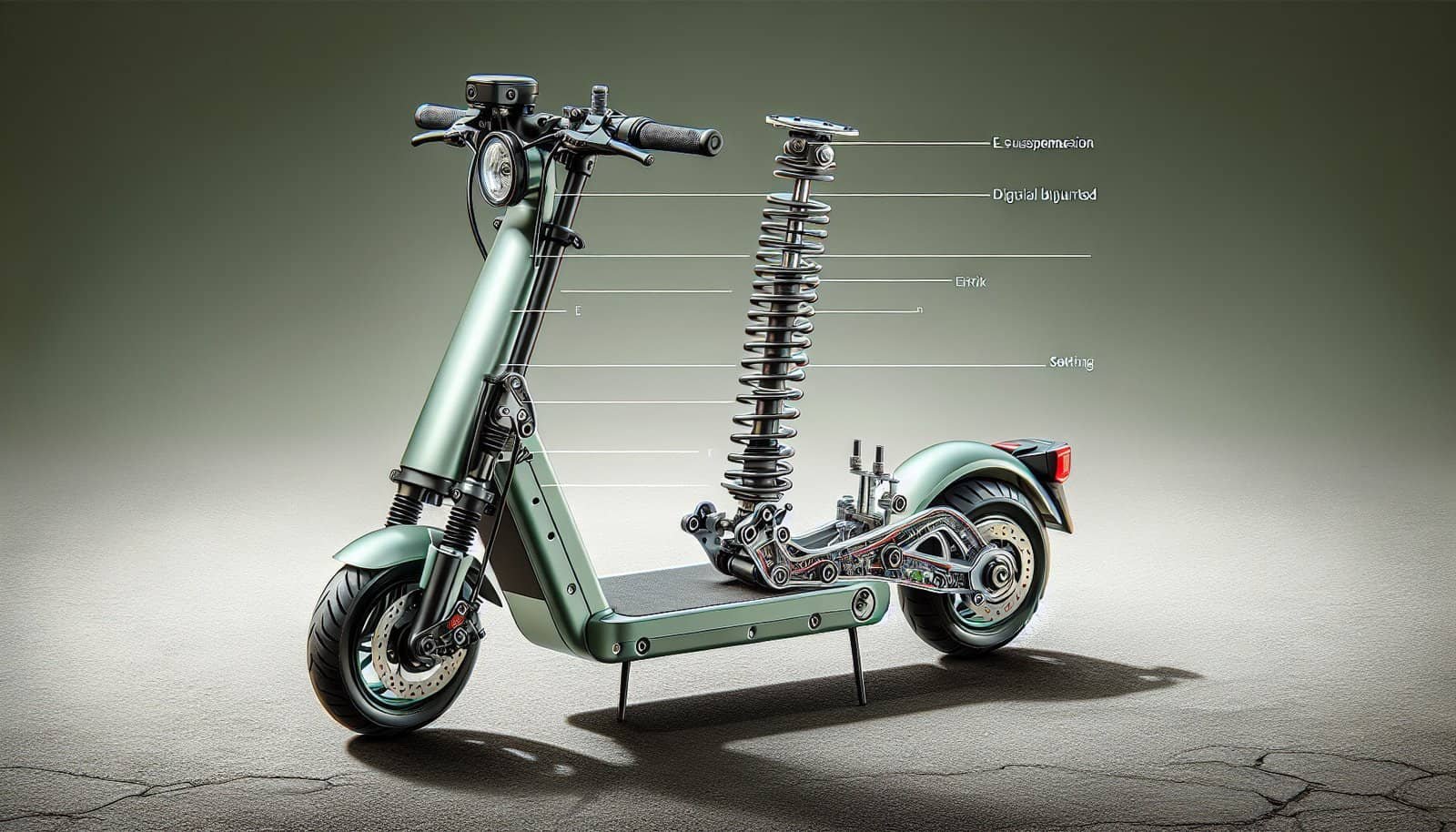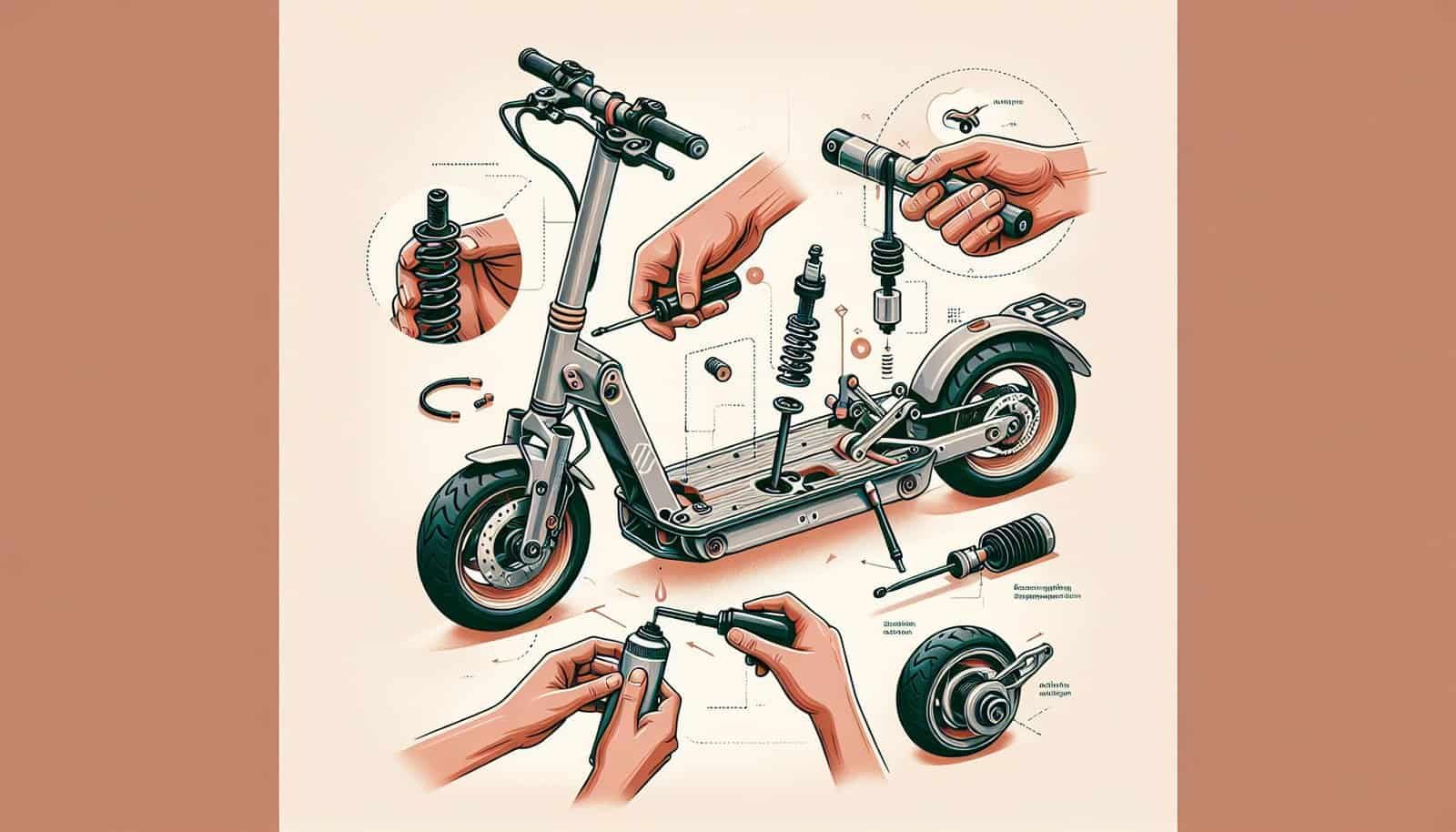Maintaining the suspension system of your electric scooter is crucial for a smooth and comfortable ride. Just like any other vehicle, the suspension system of your electric scooter needs regular care and attention to ensure optimal performance and longevity. By following a few simple steps, you can keep your scooter’s suspension in top shape and enjoy a pleasant and safe riding experience. So, gear up and let’s explore the ways to maintain the suspension system of your electric scooter.
Inspecting the Suspension System
Checking for Physical Damage
To begin maintaining your electric scooter’s suspension system, it is important to inspect it regularly for any signs of physical damage. Look for any cracks, bends, or fractures in the suspension components, such as the forks, shocks, or linkages. Check for any loose or missing bolts as well. Any physical damage can compromise the performance and safety of your scooter’s suspension, so it is crucial to address these issues promptly.
Examining Components for Wear and Tear
In addition to checking for physical damage, it is essential to examine the suspension components for wear and tear. Look for signs of corrosion, rust, or excessive wear on the forks, shocks, and linkages. Pay attention to the condition of the rubber seals and bushings, as these are prone to wear over time. If you notice any significant wear or deterioration, it may be necessary to replace these components to ensure the optimal functioning of your electric scooter’s suspension system.
Testing the Suspension’s Functionality
Another crucial aspect of maintaining your electric scooter’s suspension system is testing its functionality. To do this, gently compress and rebound the suspension by applying pressure to the handlebars or standing on the scooter while applying force downwards. Observe if the suspension smoothly absorbs and rebounds the impact, or if it feels stiff, sluggish, or excessively bouncy. A properly functioning suspension should provide a comfortable and controlled ride, absorbing bumps and vibrations effectively. If you notice any abnormalities or poor performance, it may indicate a need for adjustment or replacement of certain suspension components.
Cleaning and Lubricating the Suspension System
Cleaning the Suspension Components
Regularly cleaning the suspension components is crucial for maintaining their performance and preventing the build-up of dirt, debris, and grime. Start by thoroughly rinsing the components with water to remove loose dirt. Then, use a mild soap or specialized cleaner designed for bike or scooter suspensions to gently scrub the surfaces. Pay close attention to hard-to-reach areas, such as the fork seals and linkages. Rinse off the cleaner with water and dry the components thoroughly before moving on to the next step.
Applying Lubrication to Moving Parts
After cleaning, it is important to apply lubrication to the moving parts of the suspension system. This helps reduce friction, prolong the lifespan of the components, and maintain their smooth operation. Use a lubricant specifically formulated for bike or scooter suspensions and apply it to the fork stanchions, shock shafts, pivots, and any other moving parts according to the manufacturer’s instructions. Be cautious not to over-lubricate as excessive lubrication can attract dirt and potentially cause damage. Regularly lubricating your electric scooter’s suspension system will help ensure that it operates smoothly and remains in good condition.

Adjusting Suspension Settings
Understanding Suspension Adjustments
Electric scooters with suspension systems often come with adjustable settings to accommodate different riding preferences or terrains. Understanding these suspension adjustments is crucial for maintaining optimum performance. Common suspension settings include compression damping, rebound damping, and spring preload. Compression damping controls the resistance to compression force, while rebound damping controls the speed at which the suspension extends after compression. Spring preload, on the other hand, determines the initial tension in the suspension spring. Familiarize yourself with your scooter’s specific suspension adjustments and their effects to make informed decisions during maintenance.
Determining the Ideal Suspension Setting
The ideal suspension setting for your electric scooter depends on various factors such as your weight, riding style, and the type of terrain you typically encounter. Experiment with different settings to find the balance between comfort and performance that suits your needs. If you’re unsure where to start, referring to the manufacturer’s recommendations or seeking advice from experienced riders or scooter technicians can be beneficial. Keep in mind that the ideal suspension setting may also change over time as you gain experience and your riding preferences evolve.
How to Adjust the Suspension System
Adjusting the suspension system of your electric scooter usually involves making changes to the compression damping, rebound damping, or spring preload settings. Most scooters provide easy-to-use adjustment knobs, levers, or screws that allow for quick changes. Refer to your scooter’s user manual or consult the manufacturer’s guidelines to locate these adjustment points and learn how to make the necessary changes. It is crucial to make incremental adjustments and test the scooter’s performance after each change to ensure the desired outcome. Properly adjusting the suspension system can greatly enhance your riding experience and maintain the longevity of the components.
Replacing Suspension Components
Identifying Worn or Faulty Parts
With regular inspections, you may come across worn or faulty suspension components that require replacement. Signs of worn or faulty parts include excessive play, leaks, reduced suspension travel, or a noticeable decrease in performance. If you notice any of these issues, it is essential to accurately identify the specific component that needs replacement. Refer to your scooter’s user manual, consult a professional technician, or contact the scooter manufacturer for guidance in identifying the correct replacement parts.
Choosing Replacement Suspension Components
When choosing replacement suspension components for your electric scooter, it is crucial to select high-quality, compatible parts. Opt for genuine replacement parts from the manufacturer or trusted aftermarket brands to ensure proper fit and performance. Consider factors such as the type of riding you do, the brand and model of your scooter, and any specific requirements or recommendations from the manufacturer. If you’re uncertain, seeking guidance from a knowledgeable technician or experienced riders can help you make an informed decision.
Removing and Installing New Suspension Components
Replacing suspension components may require some mechanical knowledge or professional assistance. If you feel confident in your skills, consult your scooter’s user manual for detailed instructions on removing the old components and installing the new ones. Pay attention to proper torque specifications when tightening bolts to prevent over-tightening or damage. If you’re unsure or uncomfortable performing the replacement yourself, it is always advisable to seek the help of a professional technician. Properly replacing worn or faulty suspension components is crucial for maintaining the integrity and performance of your electric scooter’s suspension system.

Maintaining the Fork Suspension
Inspecting Fork Seals and Dust Covers
The fork suspension is a critical component of your electric scooter’s suspension system, and proper maintenance is essential for optimal performance. Regularly inspect the fork seals and dust covers for any signs of leakage, damage, or excessive wear. Damaged or worn fork seals can lead to oil leaks, reduced suspension performance, and potential damage to other components. If you notice any issues with the fork seals or dust covers, it is important to address them promptly.
Cleaning and Replacing Fork Seals
Cleaning the fork seals is an integral part of maintaining the fork suspension. Dirt, debris, or grit can get trapped in the seals and cause damage or leakage. Use a soft cloth or a specialized fork seal cleaning tool to carefully clean around the fork seals, removing any dirt or debris. If you notice any signs of damage, such as tears or cracks, it may be necessary to replace the fork seals. Consult your scooter’s user manual or seek professional assistance to ensure proper replacement of the fork seals, as it typically requires specialized tools and knowledge.
Adjusting Fork Rebound and Compression Damping
Electric scooters with adjustable suspension settings often feature separate adjustment points for fork rebound damping and compression damping. Rebound damping controls how quickly the fork extends after compression, while compression damping affects the resistance to compression force. Refer to your scooter’s user manual or the manufacturer’s instructions to locate the adjustment points for fork rebound and compression damping. Make incremental adjustments and test the scooter’s performance after each change to find the optimal setting for your riding preferences. Proper adjustment of the fork rebound and compression damping can greatly improve the comfort and control of your electric scooter.
Maintaining the Rear Suspension
Inspecting Rear Shock Absorber
The rear suspension, typically equipped with a shock absorber, also requires regular maintenance to ensure its functionality. Inspect the rear shock absorber for any signs of leakage, damage, or excessive wear. Look for oil leaks, excessive play, or changes in performance. If you notice any abnormalities, it may be necessary to address the issue to maintain the rear suspension’s functionality and safety.
Checking Rear Suspension Linkages
In addition to inspecting the rear shock absorber, it is important to check the rear suspension linkages for any signs of wear or damage. Look for loose or worn bearings, excessive play, or corrosion. The linkages ensure smooth movement and proper functioning of the rear suspension, so any issues should be addressed promptly to maintain a comfortable and controlled ride.
Adjusting Rear Suspension Rebound and Compression
Similar to the fork suspension, the rear suspension of electric scooters often provides adjustment options for rebound damping and compression damping. Pay attention to the user manual or the manufacturer’s instructions to locate the adjustment points for the rear suspension. Adjust the rebound and compression damping settings incrementally, and test the scooter’s performance after each change. Finding the appropriate rear suspension settings can greatly enhance the ride quality and overall performance of your electric scooter.

Maintaining Suspension Springs
Inspecting Spring Condition
The suspension springs play a crucial role in supporting the scooter’s weight and absorbing shocks and vibrations. Regularly inspect the springs for signs of damage, such as cracks, breaks, or deformation. If you notice any abnormalities, it is important to address them promptly. Damaged springs can negatively affect the performance and stability of your electric scooter’s suspension system.
Cleaning and Lubricating Springs
Cleaning and lubricating the suspension springs can help prevent corrosion, reduce friction, and prolong their lifespan. Use a soft cloth or a damp sponge to clean the springs, removing any dirt or debris that may have accumulated. After cleaning, apply a light coating of lubricant specifically designed for springs to the surfaces. Make sure to avoid over-lubricating, as excessive lubrication can attract dirt and cause damage. Regularly cleaning and lubricating the suspension springs will help maintain their performance and ensure a smoother riding experience.
Replacing Worn or Damaged Springs
If you identify worn or damaged springs during inspection, it is crucial to replace them promptly. Replacement springs should match the specifications and requirements of your electric scooter’s suspension system. Consult your scooter’s user manual or seek professional assistance to ensure proper selection and installation of the replacement springs. Properly functioning springs are essential for maintaining the stability, comfort, and safety of your electric scooter’s suspension system.
Maintaining Suspension Bushings
Checking Bushing Wear and Movement
Suspension bushings play a vital role in reducing friction and allowing smooth movement between different suspension components. Regularly check the bushings for signs of wear, such as cracking, deformation, or excessive play. If you notice any significant wear or movement in the bushings, it may be necessary to address the issue promptly to ensure the smooth operation and longevity of your electric scooter’s suspension system.
Lubricating and Cleaning Bushings
Lubricating and cleaning the suspension bushings is essential for maintaining their performance and preventing premature wear. Use a soft cloth or a specialized cleaning tool to remove any dirt or debris that may have accumulated on the bushings. Apply a thin layer of lubricant specifically designed for suspension bushings to reduce friction and promote smooth movement. Regularly lubricating and cleaning the suspension bushings will help prolong their lifespan and ensure optimal performance.
Replacing Worn or Damaged Bushings
If the inspection reveals worn or damaged bushings, it may be necessary to replace them to maintain the integrity and functionality of your electric scooter’s suspension system. Replacement bushings should match the specifications and requirements of your suspension system. Consult your scooter’s user manual or seek professional assistance for guidance on selecting and installing the replacement bushings. Properly functioning bushings are crucial for smooth movement and effective suspension performance.

Preventing Suspension System Damage
Avoiding Excessive Loads and Rough Terrain
One of the best ways to maintain the suspension system of your electric scooter is to prevent unnecessary stress and damage. Avoid exceeding the recommended weight capacity of the scooter, as excessive loads can put excessive strain on the suspension components. Additionally, try to avoid rough or uneven terrains that may subject the suspension system to excessive impacts or vibrations. By riding responsibly and being mindful of the scooter’s limitations, you can extend the lifespan and reliability of your suspension system.
Riding Techniques for Suspension Health
Adopting proper riding techniques is crucial for the health and maintenance of your electric scooter’s suspension system. Take care to avoid harsh impacts or jumps that can place excessive stress on the suspension components. Maintain a relaxed and balanced posture while riding, allowing the suspension system to work optimally. Gradually increase your riding skills and seek advice from experienced riders to improve your technique and minimize unnecessary strain on the suspension system.
Protecting Suspension from Moisture and Corrosion
Moisture and corrosion can significantly affect the performance and longevity of your electric scooter’s suspension system. Whenever riding in wet conditions, take extra precautions to protect the suspension components from moisture. Apply a corrosion-resistant spray to vulnerable parts, such as fork stanchions, shock absorbers, and linkages. After riding in the rain or wet conditions, thoroughly clean and dry the suspension components to remove any moisture that may have accumulated. Proper maintenance and vigilance will help prevent the detrimental effects of moisture and corrosion on your electric scooter’s suspension system.
Regular Suspension System Inspections
Establishing a Maintenance Schedule
Establishing a regular maintenance schedule is crucial for the proper care and longevity of your electric scooter’s suspension system. Depending on your usage and riding conditions, aim to conduct a comprehensive suspension system inspection every three to six months. However, if you frequently ride in demanding terrains or encounter significant impacts, more frequent inspections may be necessary. Adhering to a maintenance schedule ensures that potential issues are identified early and addressed promptly, preventing more severe damage and maintaining optimal performance.
Performing Routine Suspension Checks
During routine suspension checks, go through all the previous sections’ inspections and maintenance steps to ensure the suspension system is in good condition. Follow the guidelines outlined for inspecting physical damage, wear and tear, functionality, seals and dust covers, shock absorber, linkages, springs, and bushings. Clean and lubricate the components as necessary and adjust the suspension settings to accommodate any changes in your riding preferences or terrain. By performing these routine checks, you can catch any issues early and maintain the performance and safety of your electric scooter’s suspension system.
Addressing Issues Early
Addressing any suspension system issues promptly is crucial for maintaining the overall performance and safety of your electric scooter. If you notice any signs of physical damage, wear and tear, or reduced functionality during your inspections, take immediate action to address the problem. Whether it’s adjusting the suspension settings, lubricating components, or replacing worn or faulty parts, prompt action can prevent further damage, improve the ride quality, and ensure your electric scooter’s suspension system remains in optimal condition.
In conclusion, proper maintenance of your electric scooter’s suspension system is essential for a comfortable and safe riding experience. By regularly inspecting for physical damage and wear, cleaning and lubricating the components, adjusting suspension settings, replacing worn parts, and following good riding practices, you can ensure that your scooter’s suspension system remains in excellent condition. By taking these steps, you’re not only prolonging the life of your scooter’s suspension but also enhancing your overall riding enjoyment. So, invest a little time and effort in maintaining your suspension system, and you’ll be rewarded with a smooth and controlled ride every time you hop on your electric scooter.


